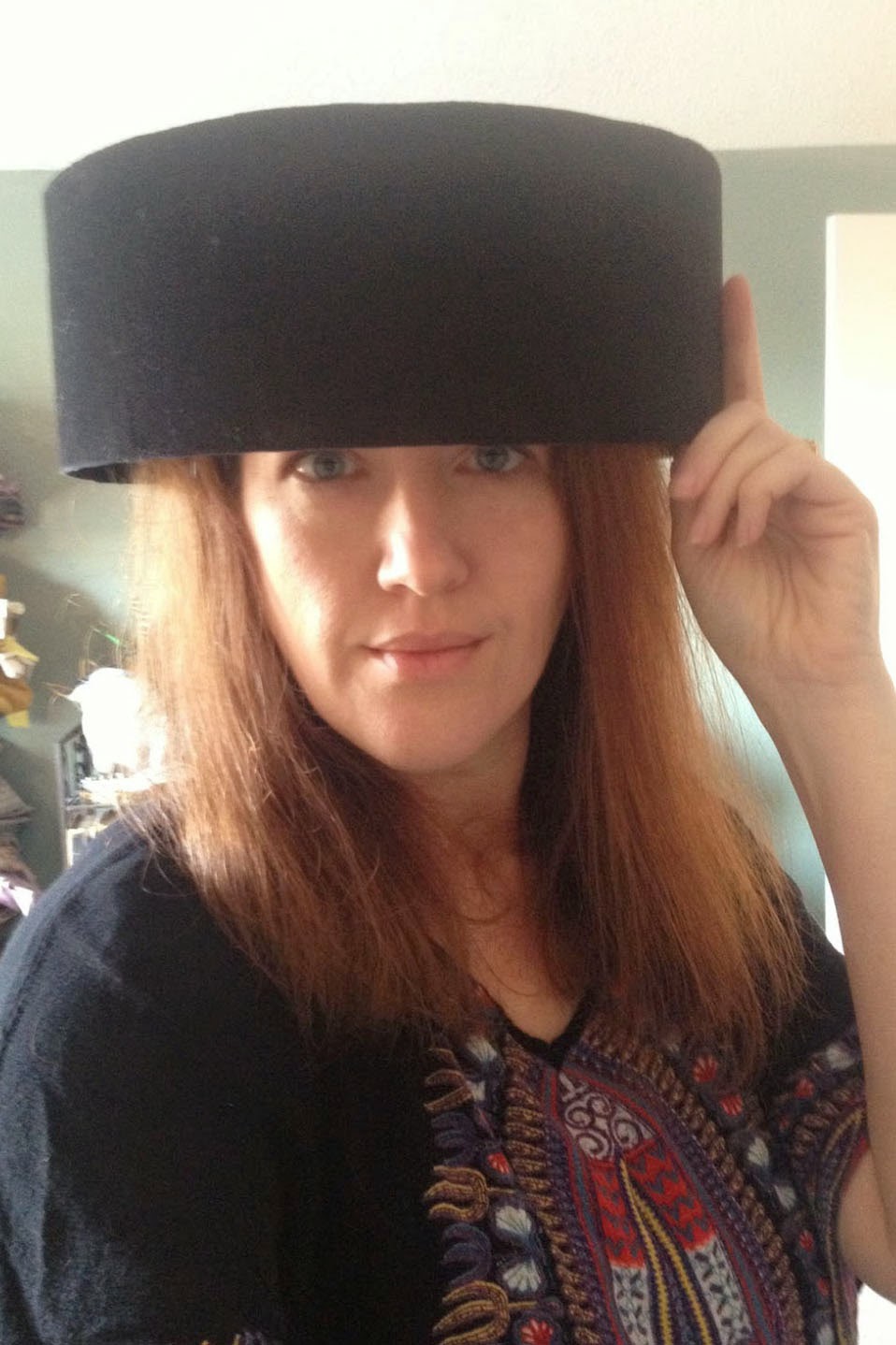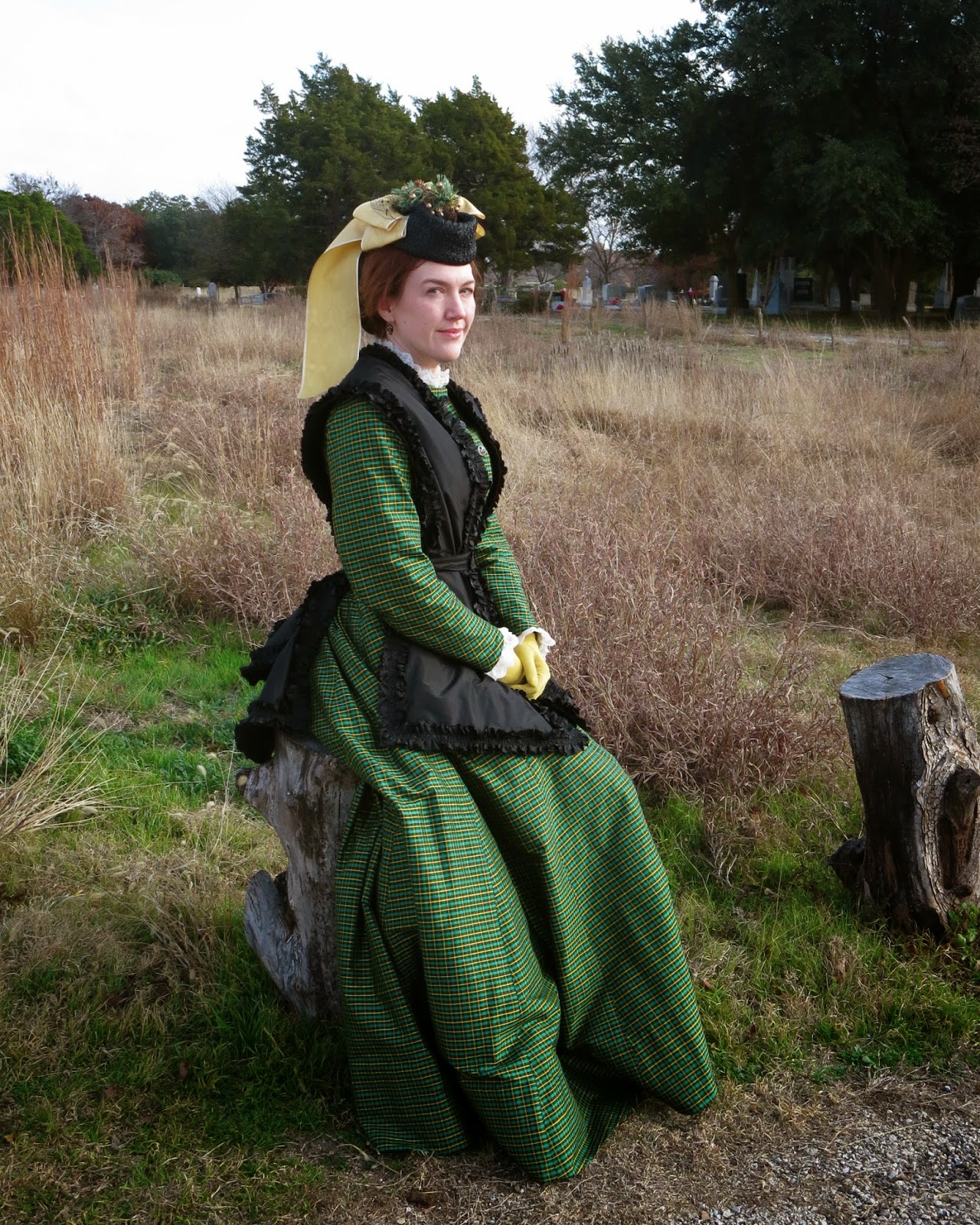 |
| Lily Elsie from The Merry Widow |
One of the main reasons that I wanted to make an Edwardian outfit for the DFWCG's Mourning Tea Party was because I've always wanted a proper "Merry Widow" hat, and a mourning party seemed like the perfect place to wear one. These fabulously oversized confections were inspired by the operetta
The Merry Widow, which took London by storm in 1907 and sparked a huge craze for the large hats worn by the leading actress, Lily Elsie. Judging by the the frequent mentions of Merry Widow hats in magazines from from this period, it seems that men found them annoying, cartoonists thought they were ridiculous, moralists saw them as sinful, and women just couldn't get enough of them! They continued to grow in size throughout the end of the Edwardian years, ultimately reaching the largest expanses ever seen in the history of fashion before finally shrinking back to a more manageable size by the mid-1910's. Since I also happen to be a huge fan of ridiculous headwear, I decided to make my own Merry Widow hat with proportions epic enough to make my Edwardian ancestors proud.
 |
| Bohemian Magazine, 1908 |
I've noticed from handling some wide-brimmed antique Edwardian hats that they are often hard as a rock, so I suspected that they used cardboard as a base instead of buckram and wire. Modern sombreros also use cardboard bases, and they are the only hats that I know of that are still as large as Edwardian Merry Widows, so I decided to experiment with converting a sombrero into a historical style. Although sombreros often show up on Ebay or Etsy, the cheapest one that I could find was
this hat from the Mariachi Connection (as a bonus, they seem to have frequent sales too). The sombrero is plain enough that you might could replace the crown only and skip recovering it, but it is covered with a a velvet-like synthetic material that I wasn't crazy about, so I decided to deconstruct the entire thing and see if I could cover the base with my own fabric for a more sophisticated look.

My first step was to remove the edge binding and decorative cords and then pull the fabric off the cardboard base. The cords and binding are sewn all the way though the cardboard, which is impressive considering how hard the base is. The fabric came off easily though, and it seemed to be glued down with something similar to rubber cement. The fabric on the entire top side of the brim was glued down, but the bottom and crown were only glued around the edges. It looked like the cardboard was shaped over some sort of block that formed the rolled edges of the brim, and the larger upturned side had several places where the cardboard was cut and overlapped to make it curl up more smoothly. Once the fabric was removed, I cut off the crown and enlarged the opening for the head to a larger size, although I did not worry about the exact size of the opening until the crown was attached.

The next step was to construct a new crown for the hat. I found an article in a 1909 edition of
La Mode Illustrée that gives a pattern and instructions for making a similar style of hat, so I used those dimensions for building my new crown. The article called for a crown that was was 10.5" in diameter, 33.5" in circumference, and 4" tall. I built my crown using a double layer of buckram with wire around the top and bottom edge, and then I covered it with cotton velveteen. It is a bit silly looking on its own, but I had fun modeling it to show you exactly how huge the crowns of Edwardian hats are supposed to be. It felt like I'm wearing a lampshade on my head at this point, but you really do need to make the crowns this large or else they don't sit correctly over the large hairstyles of the period.
After the crown was finished, I then covered the brim with my velveteen. I decided to use spray adhesive to attach the fabric to the cardboard base, and I used Scotch brand Super 77 for this project, which worked quite well. Just be sure to spray the adhesive outdoors, and do it on the grass or on newspapers because the spray glue is incredibly sticky, and it is very hard to remove if you get it on something by accident. It took me two tries to attach the fabric to the cardboard base smoothly, and there are a few tricks that I learned that made my second attempt much more successful. Please forgive my quickie hand-drawn diagrams, but hopefully they will help to illustrate the concepts.

First of all, be sure to cut your circle of fabric a good bit larger than the actual size of the hat, and don't cut out the center hole until after it is completely stuck down. It is hard to line everything up exactly when applying the fabric, and you really only have one shot at getting it on there right with the spray glue. The first time I tried it I was a little off center, and I didn't have enough fabric on one side to completely cover the edge. The second time I tried, I cut wider selvages, and I also marked the middle of the brim and the middle of the fabric with chalk so I could stick the center down first and then work my way out to the edges instead of working from one side to the other. I did this to the top side of the brim first, and then I repeated the same process on the bottom. Once it is all stuck down, then you can trim off the excess fabric and cut the opening for the crown.

The other tip that I learned is that the direction of the bias is incredibly important when trying to get the fabric to lay down smoothly over the curves in the brim. The first time I glued down the fabric, there were small wrinkles around the edges of the hat, but on the second try, I managed to smooth out all of the wrinkles by stretching the fabric on the bias in specific areas. I discovered that the straight grain needs to run up to the highest point of the upturned edge of the brim, and you will do the most stretching and smoothing along the sides of the upturn. The spray adhesive actually stays tacky and the fabric is repositionable if you don't press it down hard, so I started by sticking down the edges of the hat where the straight grain runs, then I would stretch and smooth the bias sections until all the wrinkles were gone. After stretching, then you can firmly press everything down to get a permanent bond.
The brim was finished by sewing a bias strip of the velveteen around the outside edge. This step needs to be done by hand with a curved needle, and it was a pretty long and tedious process considering how large the brims is. You probably could glue some trim around the edge instead, but I think the hand-sewn edging looked really nice, so I'm glad I took the time to do it that way.
Once the brim and crown were both covered with fabric, I attached the crown to the fabric on the top side of the hat brim - again by hand-stitching it with a curved needle. After the two parts were sewn together, I then went back and cut the round opening in the brim larger so that it fit the position and shape of the crown. The last step was to hand sew a strip of cotton around the edge of the opening for the lining of the crown. I made a casing on the top of this strip and ran a drawstring though it so that I could gather it up and adjust how high or low the hat sits on my head.
So at this point, it was finally a real hat, although quite an awkward looking one without the decorations. But never fear, because hats like these are all about the feathers and flowers and fluff. In the photo series below, you can see the hat as it looked bare, then with a super-wide vintage moire ribbon tacked around it, and then in the final shot, you can see the finished look with 5 extra long ostrich tacked across the front. Much better!
The last secret to making a Merry Widow hat look authentic is creating a large enough "Gibson girl" hairstyle to support a monster-sized hat. I taught a class on Edwardian hairstyles a few years ago, so I already had a variety of rats and hairpieces that I could use, plus a
collections of images on Pinterest to give me inspiration. My hair is just past shoulder length right now, so I wore a long wavy wig to give me some more length to work with. I used the
Stephanie wig by Wig America, and I hid the edges by combing some of my own hair over it.

The poofy sections along the front and sides of my head are made by combing the wig hair over a large rat on one side and a foam pad attached to a comb on the other. I made the rat by stuffing a stocking with wool, then I wrapped some lose braiding hair around it, then I covered it with a hair net to keep it tidy. On the back side of the rat, I have two toupee clips stitched to the stocking to hold it in place on my head. The smaller foam pad is something that I bought at a beauty supply store recently. It worked okay once I wadded some of the extra length of wig hair over it, but it was harder to secure, and I plan on replacing it with another home-made rat in the future.
Although 1910's hair-styles concentrated the fullness at the back of the head,
earlier Edwardian styles were more like a pompadour with the bulk of hair hanging over the forehead and fullness at the top and sides. To create a similar look, I did not pad the back of my hair at all, and I just twisted the back length up and pinned it into to loose curls at the crown of my head. I was in a rush on the day of the party, so my hair is a bit messier than I intended, and I could have done a better job of covering the rat and arranging the back, but it still worked out okay, and I'm sure I'll do better next time. The large size of these Gibson girl 'dos are a bit of an adjustment if you are not used to wearing big hair with your costumes, but you really do need this sort of bulk to fill out the bottom of the crown and support the wide expanse of brim.
Be sure to check back later this week for more pictures of my new Merry Widow hat and the final reveal of how the whole outfit looks together!








































.JPG)






















